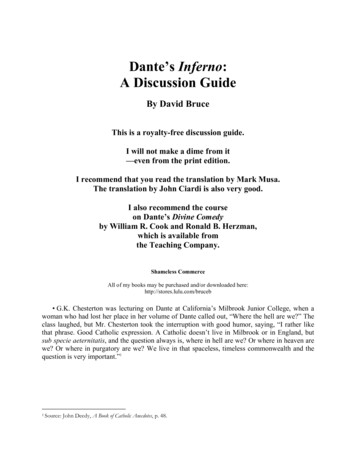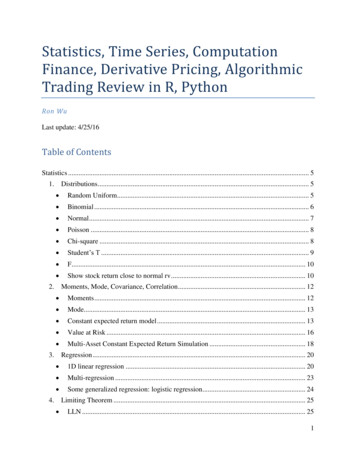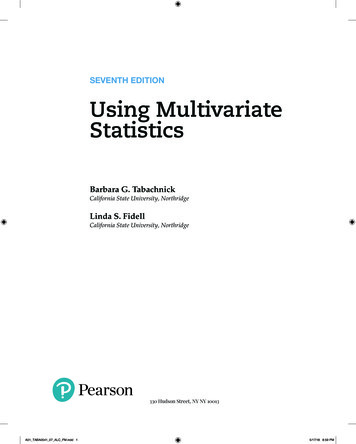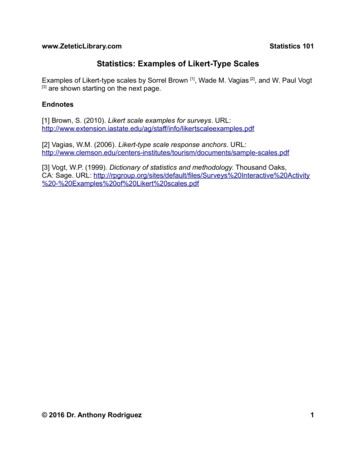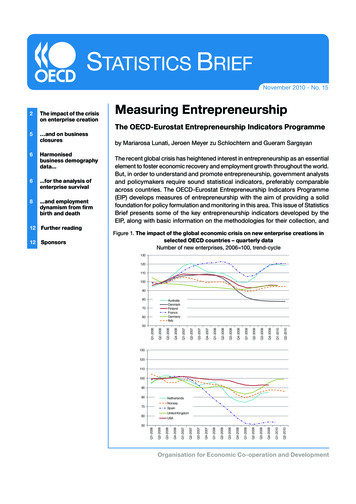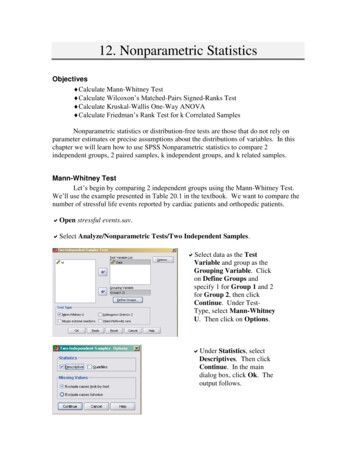
Transcription
The R InfernoPatrick Burns130th April 20111This document resides in the tutorial section of http://www.burns-stat.com. Moreelementary material on R may also be found there. S is a registered trademark ofTIBCO Software Inc. The author thanks D. Alighieri for useful comments.
ContentsContents1List of Figures6List of Tables71 Falling into the Floating Point Trap92 Growing Objects123 Failing to Vectorize173.1 Subscripting . . . . . . . . . . . . . . . . . . . . . . . . . . . . . . 203.2 Vectorized if . . . . . . . . . . . . . . . . . . . . . . . . . . . . . . 213.3 Vectorization impossible . . . . . . . . . . . . . . . . . . . . . . . 224 Over-Vectorizing5 Not5.15.25.324Writing Functions27Abstraction . . . . . . . . . . . . . . . . . . . . . . . . . . . . . . 27Simplicity . . . . . . . . . . . . . . . . . . . . . . . . . . . . . . . 32Consistency . . . . . . . . . . . . . . . . . . . . . . . . . . . . . . 336 Doing Global Assignments357 Tripping on Object Orientation7.1 S3 methods . . . . . . . . . . .7.1.1 generic functions . . . .7.1.2 methods . . . . . . . . .7.1.3 inheritance . . . . . . .7.2 S4 methods . . . . . . . . . . .7.2.1 multiple dispatch . . . .7.2.2 S4 structure . . . . . . .7.2.3 discussion . . . . . . . .7.3 Namespaces . . . . . . . . . . .1.38383939404040414242
CONTENTSCONTENTS8 Believing It Does as Intended8.1 Ghosts . . . . . . . . . . . . . . . . . . . . . .8.1.1 differences with S . . . . . . . . . . .8.1.2 package functionality . . . . . . . . . .8.1.3 precedence . . . . . . . . . . . . . . .8.1.4 equality of missing values . . . . . . .8.1.5 testing NULL . . . . . . . . . . . . . .8.1.6 membership . . . . . . . . . . . . . . .8.1.7 multiple tests . . . . . . . . . . . . . .8.1.8 coercion . . . . . . . . . . . . . . . . .8.1.9 comparison under coercion . . . . . .8.1.10 parentheses in the right places . . . .8.1.11 excluding named items . . . . . . . . .8.1.12 excluding missing values . . . . . . . .8.1.13 negative nothing is something . . . . .8.1.14 but zero can be nothing . . . . . . . .8.1.15 something plus nothing is nothing . .8.1.16 sum of nothing is zero . . . . . . . . .8.1.17 the methods shuffle . . . . . . . . . . .8.1.18 first match only . . . . . . . . . . . . .8.1.19 first match only (reprise) . . . . . . .8.1.20 partial matching can partially confuse8.1.21 no partial match assignments . . . . .8.1.22 cat versus print . . . . . . . . . . . . .8.1.23 backslashes . . . . . . . . . . . . . . .8.1.24 internationalization . . . . . . . . . . .8.1.25 paths in Windows . . . . . . . . . . .8.1.26 quotes . . . . . . . . . . . . . . . . . .8.1.27 backquotes . . . . . . . . . . . . . . .8.1.28 disappearing attributes . . . . . . . .8.1.29 disappearing attributes (reprise) . . .8.1.30 when space matters . . . . . . . . . .8.1.31 multiple comparisons . . . . . . . . . .8.1.32 name masking . . . . . . . . . . . . .8.1.33 more sorting than sort . . . . . . . . .8.1.34 sort.list not for lists . . . . . . . . . .8.1.35 search list shuffle . . . . . . . . . . . .8.1.36 source versus attach or load . . . . . .8.1.37 string not the name . . . . . . . . . .8.1.38 get a component . . . . . . . . . . . .8.1.39 string not the name (encore) . . . . .8.1.40 string not the name (yet again) . . . .8.1.41 string not the name (still) . . . . . . .8.1.42 name not the argument . . . . . . . .8.1.43 unexpected else . . . . . . . . . . . . .8.1.44 dropping dimensions . . . . . . . . . 859596060616262626363636464646565656566666767
CONTENTS8.2CONTENTS8.1.45 drop data frames . . . . . . . . . . . . . . .8.1.46 losing row names . . . . . . . . . . . . . . .8.1.47 apply function returning a vector . . . . . .8.1.48 empty cells in tapply . . . . . . . . . . . . .8.1.49 arithmetic that mixes matrices and vectors8.1.50 single subscript of a data frame or array . .8.1.51 non-numeric argument . . . . . . . . . . . .8.1.52 round rounds to even . . . . . . . . . . . .8.1.53 creating empty lists . . . . . . . . . . . . .8.1.54 list subscripting . . . . . . . . . . . . . . . .8.1.55 NULL or delete . . . . . . . . . . . . . . . .8.1.56 disappearing components . . . . . . . . . .8.1.57 combining lists . . . . . . . . . . . . . . . .8.1.58 disappearing loop . . . . . . . . . . . . . . .8.1.59 limited iteration . . . . . . . . . . . . . . .8.1.60 too much iteration . . . . . . . . . . . . . .8.1.61 wrong iterate . . . . . . . . . . . . . . . . .8.1.62 wrong iterate (encore) . . . . . . . . . . . .8.1.63 wrong iterate (yet again) . . . . . . . . . .8.1.64 iterate is sacrosanct . . . . . . . . . . . . .8.1.65 wrong sequence . . . . . . . . . . . . . . . .8.1.66 empty string . . . . . . . . . . . . . . . . .8.1.67 NA the string . . . . . . . . . . . . . . . . .8.1.68 capitalization . . . . . . . . . . . . . . . . .8.1.69 scoping . . . . . . . . . . . . . . . . . . . .8.1.70 scoping (encore) . . . . . . . . . . . . . . .Chimeras . . . . . . . . . . . . . . . . . . . . . . .8.2.1 numeric to factor to numeric . . . . . . . .8.2.2 cat factor . . . . . . . . . . . . . . . . . . .8.2.3 numeric to factor accidentally . . . . . . . .8.2.4 dropping factor levels . . . . . . . . . . . .8.2.5 combining levels . . . . . . . . . . . . . . .8.2.6 do not subscript with factors . . . . . . . .8.2.7 no go for factors in ifelse . . . . . . . . . . .8.2.8 no c for factors . . . . . . . . . . . . . . . .8.2.9 ordering in ordered . . . . . . . . . . . . . .8.2.10 labels and excluded levels . . . . . . . . . .8.2.11 is missing missing or missing? . . . . . . . .8.2.12 data frame to character . . . . . . . . . . .8.2.13 nonexistent value in subscript . . . . . . . .8.2.14 missing value in subscript . . . . . . . . . .8.2.15 all missing subscripts . . . . . . . . . . . . .8.2.16 missing value in if . . . . . . . . . . . . . .8.2.17 and and andand . . . . . . . . . . . . . . .8.2.18 equal and equalequal . . . . . . . . . . . . .8.2.19 is.integer . . . . . . . . . . . . . . . . . . 878788082828283838484848585868788888990909091
3.168.3.178.3.188.3.198.3.20CONTENTSis.numeric, as.numeric with integers . . . . . . . .is.matrix . . . . . . . . . . . . . . . . . . . . . . . .max versus pmax . . . . . . . . . . . . . . . . . . .all.equal returns a surprising value . . . . . . . . .all.equal is not identical . . . . . . . . . . . . . . .identical really really means identical . . . . . . . . is not a synonym of - . . . . . . . . . . . . . .complex arithmetic . . . . . . . . . . . . . . . . . .complex is not numeric . . . . . . . . . . . . . . .nonstandard evaluation . . . . . . . . . . . . . . .help for for . . . . . . . . . . . . . . . . . . . . . .subset . . . . . . . . . . . . . . . . . . . . . . . . . vs in subset . . . . . . . . . . . . . . . . . .single sample switch . . . . . . . . . . . . . . . . .changing names of pieces . . . . . . . . . . . . . .a puzzle . . . . . . . . . . . . . . . . . . . . . . . .another puzzle . . . . . . . . . . . . . . . . . . . .data frames vs matrices . . . . . . . . . . . . . . .apply not for data frames . . . . . . . . . . . . . .data frames vs matrices (reprise) . . . . . . . . . .names of data frames and matrices . . . . . . . . .conflicting column names . . . . . . . . . . . . . .cbind favors matrices . . . . . . . . . . . . . . . . .data frame equal number of rows . . . . . . . . . .matrices in data frames . . . . . . . . . . . . . . . . . . . . . . . . . . . . . . . . . . . . . . . . . . .read.table . . . . . . . . . . . . . . . . . . . . . . .read a table . . . . . . . . . . . . . . . . . . . . . .the missing, the whole missing and nothing but themisquoting . . . . . . . . . . . . . . . . . . . . . .thymine is TRUE, female is FALSE . . . . . . . .whitespace is white . . . . . . . . . . . . . . . . . .extraneous fields . . . . . . . . . . . . . . . . . . .fill and extraneous fields . . . . . . . . . . . . . . .reading messy files . . . . . . . . . . . . . . . . . .imperfection of writing then reading . . . . . . . .non-vectorized function in integrate . . . . . . . .non-vectorized function in outer . . . . . . . . . .ignoring errors . . . . . . . . . . . . . . . . . . . .accidentally global . . . . . . . . . . . . . . . . . .handling . . . . . . . . . . . . . . . . . . . . . . .laziness . . . . . . . . . . . . . . . . . . . . . . . .lapply laziness . . . . . . . . . . . . . . . . . . . .invisibility cloak . . . . . . . . . . . . . . . . . . .evaluation of default arguments . . . . . . . . . . .sapply simplification . . . . . . . . . . . . . . . . .4. . . . 91. . . . 92. . . . 92. . . . 93. . . . 93. . . . 93. . . . 94. . . . 94. . . . 94. . . . 95. . . . 95. . . . 96. . . . 96. . . . 96. . . . 97. . . . 97. . . . 98. . . . 98. . . . 98. . . . 98. . . . 99. . . . 99. . . . 100. . . . 100. . . . 100. . . . 101. . . . 101. . . . 101missing102. . . . 102. . . . 102. . . . 104. . . . 104. . . . 104. . . . 105. . . . 105. . . . 105. . . . 106. . . . 106. . . . 107. . . . 107. . . . 108. . . . 108. . . . 109. . . . 109. . . . 110
nal arrays . . .by is for data frames . . . .stray backquote . . . . . . .array dimension calculationreplacing pieces of a matrixreserved words . . . . . . .return is a function . . . . .return is a function (still) .BATCH failure . . . . . . .corrupted .RData . . . . . .syntax errors . . . . . . . .general confusion . . . . . .9 Unhelpfully Seeking Help9.1 Read the documentation . . .9.2 Check the FAQ . . . . . . . .9.3 Update . . . . . . . . . . . .9.4 Read the posting guide . . . .9.5 Select the best list . . . . . .9.6 Use a descriptive subject line9.7 Clearly state your question .9.8 Give a minimal example . . .9.9 Wait . . . . . . . . . . . . . 1161161171171181181201211235
List of Figures2.1The giants by Sandro Botticelli. . . . . . . . . . . . . . . . . . . .143.1The hypocrites by Sandro Botticelli. . . . . . . . . . . . . . . . .194.1The panderers and seducers and the flatterers by Sandro Botticelli. 255.1Stack of environments through time. . . . . . . . . . . . . . . . .326.1The sowers of discord by Sandro Botticelli. . . . . . . . . . . . .367.1The Simoniacs by Sandro Botticelli. . . . . . . . . . . . . . . . .418.18.2The falsifiers: alchemists by Sandro Botticelli. . . . . . . . . . . . 47The treacherous to kin and the treacherous to country by SandroBotticelli. . . . . . . . . . . . . . . . . . . . . . . . . . . . . . . . 81The treacherous to country and the treacherous to guests andhosts by Sandro Botticelli. . . . . . . . . . . . . . . . . . . . . . . 1038.39.19.2The thieves by Sandro Botticelli. . . . . . . . . . . . . . . . . . . 116The thieves by Sandro Botticelli. . . . . . . . . . . . . . . . . . . 1196
List of Tables2.1Time in seconds of methods to create a sequence. . . . . . . . . .123.1Summary of subscripting with 8 [ 8 . . . . . . . . . . . . . . . . . .204.1The apply family of functions. . . . . . . . . . . . . . . . . . . . .245.15.2Simple objects. . . . . . . . . . . . . . . . . . . . . . . . . . . . .Some not so simple objects. . . . . . . . . . . . . . . . . . . . . .29298.18.2A few of the most important backslashed characters. . . . . . . .Functions to do with quotes. . . . . . . . . . . . . . . . . . . . .59617
PrefaceAbstract: If you are using R and you think you’re in hell, this is a map foryou.wandered throughhttp://www.r-project.org.To state the good I found there, I’ll also say what else I saw.Having abandoned the true way, I fell into a deep sleep and awoke in a deepdark wood. I set out to escape the wood, but my path was blocked by a lion.As I fled to lower ground, a figure appeared before me. “Have mercy on me,whatever you are,” I cried, “whether shade or living human.”“Not a man, though once I was. My parents were from Lombardy. I wasborn sub Julio and lived in Rome in an age of false and lying gods.”“Are you Virgil, the fountainhead of such a volume?”“I think it wise you follow me. I’ll lead you through an eternal place whereyou shall hear despairing cries and see those ancient souls in pain as they grievetheir second death.”After a journey, we arrived at an archway. Inscribed on it: “Through methe way into the suffering city, through me the way among the lost.” Throughthe archway we went.Now sighing and wails resounded through the starless air, so that I toobegan weeping. Unfamiliar tongues, horrendous accents, cries of rage—all ofthese whirled in that dark and timeless air.8
Circle 1Falling into the FloatingPoint TrapOnce we had crossed the Acheron, we arrived in the first Circle, home of thevirtuous pagans. These are people who live in ignorance of the Floating PointGods. These pagans expect.1 .3 / 3to be true.The virtuous pagans will also expectseq(0, 1, by .1) .3to have exactly one value that is true.But you should not expect something like:unique(c(.3, .4 - .1, .5 - .2, .6 - .3, .7 - .4))to have length one.I wrote my first program in the late stone age. The task was to programthe quadratic equation. Late stone age means the medium of expression waspunchcards. There is no backspace on a punchcard machine—once the holesare there, there’s no filling them back in again. So a typo at the end of a linemeans that you have to throw the card out and start the line all over again. Aprocedure with which I became all too familiar.Joy ensued at the end of the long ordeal of acquiring a pack of properlypunched cards. Short-lived joy. The next step was to put the stack of cardsinto an in-basket monitored by the computer operator. Some hours later the(large) paper output from the job would be in a pigeonhole. There was of coursean error in the program. After another struggle with the punchcard machine(relatively brief this time), the card deck was back in the in-basket.9
CIRCLE 1. FALLING INTO THE FLOATING POINT TRAPIt didn’t take many iterations before I realized that it only ever told meabout the first error it came to. Finally on the third day, the output featuredno messages about errors. There was an answer—a wrong answer. It was asimple quadratic equation, and the answer was clearly 2 and 3. The programsaid it was 1.999997 and 3.000001. All those hours of misery and it can’t evenget the right answer.I can write an R function for the quadratic formula somewhat quicker. quadratic.formulafunction (a, b, c){rad - b 2 - 4 * a * cif(is.complex(rad) all(rad 0)) {rad - sqrt(rad)} else {rad - sqrt(as.complex(rad))}cbind(-b - rad, -b rad) / (2 * a)} quadratic.formula(1, -5, 6)[,1] [,2][1,]23 quadratic.formula(1, c(-5, 1), 6)[,1][,2][1,] 2.0 0.000000i 3.0 0.000000i[2,] -0.5-2.397916i -0.5 2.397916iIt is more general than that old program, and more to the point it gets theright answer of 2 and 3. Except that it doesn’t. R merely prints so that mostnumerical error is invisible. We can see how wrong it actually is by subtractingthe right answer: quadratic.formula(1, -5, 6) - c(2, 3)[,1] [,2][1,]00Well okay, it gets the right answer in this case. But there is error if we changethe problem a little: quadratic.formula(1/3, -5/3, 6/3)[,1] [,2][1,]23 print(quadratic.formula(1/3, -5/3, 6/3), digits 16)[1,] 1.999999999999999 3.000000000000001 quadratic.formula(1/3, -5/3, 6/3) - c(2, 3)[,1][,2][1,] -8.881784e-16 1.332268e-1510
CIRCLE 1. FALLING INTO THE FLOATING POINT TRAPThat R prints answers nicely is a blessing. And a curse. R is good enough athiding numerical error that it is easy to forget that it is there. Don’t forget.Whenever floating point operations are done—even simple ones, you shouldassume that there will be numerical error. If by chance there is no error, regardthat as a happy accident—not your due. You can use the all.equal functioninstead of 8 8 to test equality of floating point numbers.If you have a case where the numbers are logically integer but they havebeen computed, then use round to make sure they really are integers.Do not confuse numerical error with an error. An error is when a computation is wrongly performed. Numerical error is when there is visible noiseresulting from the finite representation of numbers. It is numerical error—notan error—when one-third is represented as 33%.We’ve seen another aspect of virtuous pagan beliefs—what is printed is allthat there is. 7/13 - 3/31[1] 0.4416873R prints—by default—a handy abbreviation, not all that it knows about numbers: print(7/13 - 3/31, digits 16)[1] 0.4416873449131513Many summary functions are even more restrictive in what they print: summary(7/13 - 3/31)Min. 1st Qu. Median0.4417 0.4417 0.4417Mean 3rd Qu.0.4417 0.4417Max.0.4417Numerical error from finite arithmetic can not only fuzz the answer, it can fuzzthe question. In mathematics the rank of a matrix is some specific integer. Incomputing, the rank of a matrix is a vague concept. Since eigenvalues need notbe clearly zero or clearly nonzero, the rank need not be a definite number.We descended to the edge of the first Circle where Minos stands guard,gnashing his teeth. The number of times he wraps his tail around himselfmarks the level of the sinner before him.11
Circle 2Growing ObjectsWe made our way into the second Circle, here live the gluttons.Let’s look at three ways of doing the same task of creating a sequence ofnumbers. Method 1 is to grow the object:vec - numeric(0)for(i in 1:n) vec - c(vec, i)Method 2 creates an object of the final length and then changes the values inthe object by subscripting:vec - numeric(n)for(i in 1:n) vec[i] - iMethod 3 directly creates the final object:vec - 1:nTable 2.1 shows the timing in seconds on a particular (old) machine of thesethree methods for a selection of values of n. The relationships for varying n areall roughly linear on a log-log scale, but the timings are drastically different.You may wonder why growing objects is so slow. It is the computationalequivalent of suburbanization. When a new size is required, there will not beTable 2.1: Time in seconds of methods to create a 3.6818,718subscript0.010.090.798.1012colon operator.00006.0004.005.097
CIRCLE 2. GROWING OBJECTSenough room where the object is; so it needs to move to a more open space.Then that space will be too small, and it will need to move again. It takes a lotof time to move house. Just as in physical suburbanization, growing objects canspoil all of the available space. You end up with lots of small pieces of availablememory, but no large pieces. This is called fragmenting memory.A more common—and probably more dangerous—means of being a gluttonis with rbind. For example:my.df - data.frame(a character(0), b numeric(0))for(i in 1:n) {my.df - rbind(my.df, data.frame(a sample(letters, 1),b runif(1)))}Probably the main reason this is more common is because it is more likely thateach iteration will have a different number of observations. That is, the code ismore likely to look like:my.df - data.frame(a character(0), b numeric(0))for(i in 1:n) {this.N - rpois(1, 10)my.df - rbind(my.df, data.frame(a sample(letters,this.N, replace TRUE), b runif(this.N)))}Often a reasonable upper bound on the size of the final object is known. If so,then create the object with that size and then remove the extra values at theend. If the final size is a mystery, then you can still follow the same scheme,but allow for periodic growth of the object.current.N - 10 * nmy.df - data.frame(a character(current.N),b numeric(current.N))count - 0for(i in 1:n) {this.N - rpois(1, 10)if(count this.N current.N) {old.df - my.dfcurrent.N - round(1.5 * (current.N this.N))my.df - data.frame(a character(current.N),b numeric(current.N))my.df[1:count,] - old.df[1:count, ]}my.df[count 1:this.N,] - data.frame(a sample(letters,this.N, replace TRUE), b runif(this.N))count - count this.N}my.df - my.df[1:count,]13
CIRCLE 2. GROWING OBJECTSFigure 2.1: The giants by Sandro Botticelli.Often there is a simpler approach to the whole problem—build a list of piecesand then scrunch them together in one go.my.list - vector(’list’, n)for(i in 1:n) {this.N - rpois(1, 10)my.list[[i]] - data.frame(a sample(letters, this.Nreplace TRUE), b runif(this.N))}my.df - do.call(’rbind’, my.list)There are ways of cleverly hiding that you are growing an object. Here is anexample:hit - NAfor(i in 1:one.zillion) {if(runif(1) 0.3) hit[i] - TRUE}Each time the condition is true, hit is grown.Eliminating the growth of objects can be one of the easiest and most dramatic ways of speeding up R code.14
CIRCLE 2. GROWING OBJECTSIf you use too much memory, R will complain. The key issue is that R holdsall the data in RAM. This is a limitation if you have huge datasets. The up-sideis flexibility—in particular, R imposes no rules on what data are like.You can get a message, all too familiar to some people, like:Error: cannot allocate vector of size 79.8 Mb.This is often misinterpreted along the lines of: “I have xxx gigabytes of memory,why can’t R even allocate 80 megabytes?” It is because R has already allocateda lot of memory successfully. The error message is about how much memory Rwas going after at the point where it failed.The user who has seen this message logically asks, “What can I do aboutit?” There are some easy answers:1. Don’t be a glutton by using bad programming constructs.2. Get a bigger computer.3. Reduce the problem size.If you’ve obeyed the first answer and can’t follow the second or third, thenyour alternatives are harder. One is to restart the R session, but this is oftenineffective.Another of those hard alternatives is to explore where in your code thememory is growing. One method (on at least one platform) is to insert lineslike:cat(’point 1 mem’, memory.size(), memory.size(max TRUE), ’\n’)throughout your code. This shows the memory that R currently has and themaximum amount R has had in the current session.However, probably a more efficient and informative procedure would be touse Rprof with memory profiling. Rprof also profiles time use.Another way of reducing memory use is to store your data in a database andonly extract portions of the data into R as needed. While this takes some timeto set up, it can become quite a natural way to work.A “database” solution that only uses R is to save (as in the save function)objects in individual files, then use the files one at a time. So your code usingthe objects might look something like:for(i in 1:n) {objname - paste(’obj.’, i, sep ’’)load(paste(objname, ’.rda’, sep ’’))the obj - get(objname)rm(list objname)# use the obj}15
CIRCLE 2. GROWING OBJECTSAre tomorrow’s bigger computers going to solve the problem? For some people,yes—their data will stay the same size and computers will get big enough tohold it comfortably. For other people it will only get worse—more powerfulcomputers means extraordinarily larger datasets. If you are likely to be in thislatter group, you might want to get used to working with databases now.If you have one of those giant computers, you may have the capacity toattempt to create something larger than R can handle. See:?’Memory-limits’for the limits that are imposed.16
Circle 3Failing to VectorizeWe arrive at the third Circle, filled with cold, unending rain. Here standsCerberus barking out of his three throats. Within the Circle were the blasphemous wearing golden, dazzling cloaks that inside were all of lead—weighingthem down for all of eternity. This is where Virgil said to me, “Remember yourscience—the more perfect a thing, the more its pain or pleasure.”Here is some sample code:lsum - 0for(i in 1:length(x)) {lsum - lsum log(x[i])}No. No. No.This is speaking R with a C accent—a strong accent. We can do the samething much simpler:lsum - sum(log(x))This is not only nicer for your carpal tunnel, it is computationally much faster.(As an added bonus it avoids the bug in the loop when x has length zero.)The command above works because of vectorization. The log function isvectorized in the traditional sense—it does the same operation on a vector ofvalues as it would do on each single value. That is, the command:log(c(23, 67.1))has the same result as the command:c(log(23), log(67.1))The sum function is vectorized in a quite different sense—it takes a vector andproduces something based on the whole vector. The command sum(x) is equivalent to:17
CIRCLE 3. FAILING TO VECTORIZEx[1] x[2] . x[length(x)]The prod function is similar to sum, but does products rather than sums. Products can often overflow or underflow (a suburb of Circle 1)—taking logs anddoing sums is generally a more stable computation.You often get vectorization for free. Take the example of quadratic.formulain Circle 1 (page 9). Since the arithmetic operators are vectorized, the result ofthis function is a vector if any or all of the inputs are. The only slight problemis that there are two answers per input, so the call to cbind is used to keeptrack of the pairs of answers.In binary operations such as:c(1,4) 1:10recycling automatically happens along with the vectorization.Here is some code that combines both this Circle and Circle 2 (page 12):ans - NULLfor(i in 1:507980) {if(x[i] 0) ans - c(ans, y[i])}This can be done simply with:ans - y[x 0]A double for loop is often the result of a function that has been directly translated from another language. Translations that are essentially verbatim areunlikely to be the best thing to do. Better is to rethink what is happening withR in mind. Using direct translations from another language may well leave youlonging for that other language. Making good translations may well leave youmarvelling at R’s strengths. (The catch is that you need to know the strengthsin order to make the good translations.)If you are translating code into R that has a double for loop, think.If your function is not vectorized, then you can possibly use the Vectorizefunction to make a vectorized version. But this is vectorization from an externalpoint of view—it is not the same as writing inherently vectorized code. TheVectorize function performs a loop using the original function.Some functions take a function as an argument and demand that the functionbe vectorized—these include outer and integrate.There is another form of vectorization: max(2, 100, -4, 3, 230, 5)[1] 230 range(2, 100, -4, 3, 230, 5, c(4, -456, 9))[1] -456 23018
CIRCLE 3. FAILING TO VECTORIZEFigure 3.1: The hypocrites by Sandro Botticelli.This form of vectorization is to treat the collection of arguments as the vector.This is NOT a form of vectorization you should expect, it is essentially foreign toR—min, max, range, sum and prod are rare exceptions. In particular, mean doesnot adhere to this form of vectorization, and unfortunately does not generatean error from trying it: mean(2, -100, -4, 3, -230, 5)[1] 2But you get the correct answer if you add three (particular) keystrokes: mean(c(2, -100, -4, 3, -230, 5))[1] -54One reason for vectorization is for computational speed. In a vector operationthere is always a loop. If the loop is done in C code, then it will be much fasterthan if it is done in R code. In some cases, this can be very important. Inother cases, it isn’t—a loop in R code now is as fast as the same loop in C ona computer from a few years ago.Another reason to vectorize is for clarity. The command:volume - width * depth * height19
3.1. SUBSCRIPTINGCIRCLE 3. FAILING TO VECTORIZETable 3.1: Summary of subscripting with 8 [ 8 .subscripteffectpositive numeric vectorselects items with those indicesnegative numeric vectorselects all but those indicescharacter vectorselects items with those names (or dimnames)logical vectorselects the TRUE (and NA) itemsmissingselects allclearly expresses the relation between the variables. This same clarity is presentwhether there is one item or a million. Transparent code is an important form ofefficiency. Computer time is cheap, human time (and frustration) is expensive.This fact is enshrined in the maxim of Uwe Ligges.Uwe0 s Maxim Computers are cheap, and thinking hurts.A fairly common question from new users is: “How do I assign names to agroup of simi
Contents Contents 1 List of Figures 6 List of Tables 7 1 Falling into the Floating Point Trap 9 2 Growing



